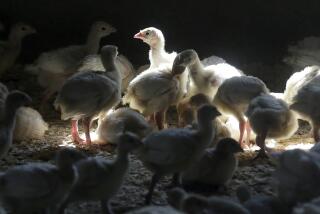Bird Flu Strain Expected to Land in U.S. This Year
WASHINGTON — Adding urgency to preparations for a possible influenza pandemic among humans, a top federal official said Monday that wild birds infected with a virulent strain of avian flu were expected to show up on the U.S. mainland later this year.
“We assume wild birds will come to the United States sometime between now and the fall,” Health and Human Services Secretary Mike Leavitt said in the most specific estimate yet by a senior official.
Finding an infected bird here would not create a public health emergency, officials said, since the avian flu virus has not developed the ability to spread easily among humans. But it would highlight that U.S. preparedness plans are years from completion.
Since it was first identified in 1997, the deadly H5N1 virus has been confined mainly to birds in China and Southeast Asia. In the last few months, it has begun spreading among birds in Europe, Africa and the Middle East.
Some scientists believe migratory birds crossing from Asia into Alaska and down the West Coast could bring the virus. Others see a threat from the thriving illegal importation of exotic birds, which are not routinely screened for disease.
The Bush administration is seeking to develop new ways to quickly produce massive quantities of vaccine, and it is purchasing and stockpiling antiviral medications to treat victims. Congress has provided $3.3 billion in funding out of a $7.1-billion White House request.
But the vaccine program is expected to take three to five years to bear fruit. Separately, because of supply constraints, the administration’s goal of purchasing enough antiviral medications to treat a quarter of the population may not be met until the end of 2008.
“We might have the science, but we still don’t have the vaccine manufacturing capacity or the distribution system to get vaccine into people’s arms,” said Kim Elliott, deputy director of the Trust for America’s Health.
At an American Medical Assn. meeting in Washington, Leavitt said the government was working on a plan to inform people about risks and precautions once the bird flu appears.
“As long as it is a bird disease, it is not a crisis,” he said.
Although more than half of the 176 people infected with H5N1 since 2003 have died, virtually all of them are believed to have gotten sick from direct contact with birds. The risk could be lower in the United States, because relatively few people keep live poultry around their houses. Also, chickens and turkeys here are usually raised in huge indoor barns, where they can be isolated from migratory birds.
If the virus becomes easily transmissible among people, it will probably happen in an agricultural country where people have frequent contact with domestic animals, Leavitt said, noting that the new strain of the virus -- sometimes called the pandemic strain -- could show up in the United States 30 to 40 days after it first appears.
At that point, there would be no effective vaccine for humans. Even with dramatic improvements in production, it would take about six months to produce a vaccine tailored to the pandemic strain of the virus. The government has limited quantities of vaccine available against H5N1, but not the as-yet-unknown pandemic strain.
“If we have person-to-person transmission and enter the pandemic condition, we’ll be operating without a vaccine for the first six months,” Leavitt said. “We’ll be dependent upon traditional public health measures to contain and limit it.”
Traditional public health measures include closing schools and suspending public meetings and church services.
Leavitt is holding meetings in every state, urging local authorities to develop contingency plans. If a flu pandemic does break out, the country will need assistance. Estimates of deaths range from 209,000 to 1.9 million.
“This is different from any other emergency we manage,” Leavitt said. “There is no way to respond to 5,000 communities at the same time.”
More to Read
Sign up for Essential California
The most important California stories and recommendations in your inbox every morning.
You may occasionally receive promotional content from the Los Angeles Times.










